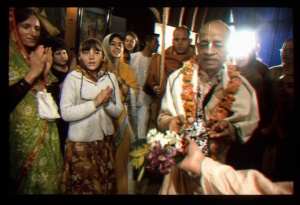CC Adi 3.7 (1975): Difference between revisions
(Vanibot #0027: CCMirror - Mirror CC's 1996 edition to form a basis for 1975) |
(Vanibot #0020: VersionCompareLinker - added a link to the Version Compare feature) |
||
| Line 2: | Line 2: | ||
<div style="float:left">'''[[Sri Caitanya-caritamrta (1975)|Śrī Caitanya-caritāmṛta (1975)]] - [[CC Adi (1975)|Ādi-līlā]] - [[CC Adi 3 (1975)|Chapter 3: The External Reasons for the Appearance of Śrī Caitanya Mahāprabhu]]'''</div> | <div style="float:left">'''[[Sri Caitanya-caritamrta (1975)|Śrī Caitanya-caritāmṛta (1975)]] - [[CC Adi (1975)|Ādi-līlā]] - [[CC Adi 3 (1975)|Chapter 3: The External Reasons for the Appearance of Śrī Caitanya Mahāprabhu]]'''</div> | ||
<div style="float:right">[[File:Go-previous.png|link=CC Adi 3.6 (1975)|Ādi-līlā 3.6]] '''[[CC Adi 3.6 (1975)|Ādi-līlā 3.6]] - [[CC Adi 3.8 (1975)|Ādi-līlā 3.8]]''' [[File:Go-next.png|link=CC Adi 3.8 (1975)|Ādi-līlā 3.8]]</div> | <div style="float:right">[[File:Go-previous.png|link=CC Adi 3.6 (1975)|Ādi-līlā 3.6]] '''[[CC Adi 3.6 (1975)|Ādi-līlā 3.6]] - [[CC Adi 3.8 (1975)|Ādi-līlā 3.8]]''' [[File:Go-next.png|link=CC Adi 3.8 (1975)|Ādi-līlā 3.8]]</div> | ||
{{CompareVersions|CC|Adi 3.7|CC 1975|CC 1996}} | |||
{{RandomImage}} | {{RandomImage}} | ||
==== TEXT 7 ==== | ==== TEXT 7 ==== | ||
| Line 25: | Line 24: | ||
<div class="translation"> | <div class="translation"> | ||
We know that there are four ages [yugas], namely Satya, Tretā, Dvāpara and Kali. These four together | We know that there are four ages [yugas], namely Satya, Tretā, Dvāpara and Kali. These four together comprise one divya-yuga. | ||
</div> | </div> | ||
Latest revision as of 17:25, 26 January 2020
Śrī Caitanya-caritāmṛta (1975) - Ādi-līlā - Chapter 3: The External Reasons for the Appearance of Śrī Caitanya Mahāprabhu

His Divine Grace
A.C. Bhaktivedanta Swami Prabhupada
A.C. Bhaktivedanta Swami Prabhupada
TEXT 7
- satya, tretā, dvāpara, kali, cāri-yuga jāni
- sei cāri-yuge divya eka-yuga māni
SYNONYMS
satya—Satya; tretā—Tretā; dvāpara—Dvāpara; kali—Kali; cāri-yuga—four ages; jāni—we know; sei—these; cāri-yuge—in the four ages; divya—divine; eka-yuga—one age; māni—we consider.
TRANSLATION
We know that there are four ages [yugas], namely Satya, Tretā, Dvāpara and Kali. These four together comprise one divya-yuga.